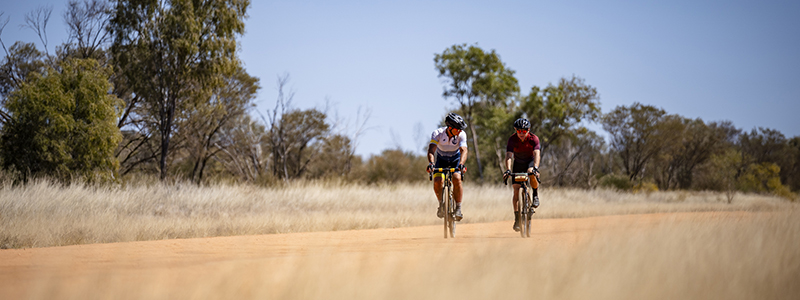The following information and advice is provided to help riders, and particularly first timers, prepare for the event. If you are new to gravel riding, or this is your first stage race then this information will help you understand what you’ve got ahead of you and provide guidance to help ensure you have a great race on the day (which you will!).
Basic Guidelines for Event Training and Preparation
These basic pointers will help keep your expectations for the Gravel Muster realistic to ensure you enjoy your week.
- Keep things in perspective – remember that the emphasis should be on enjoyment, satisfaction and fun. Training and racing shouldn’t be a chore.
- Listen to your body. If you’re feeling unwell, don’t train on regardless. As a general rule of thumb for head colds, if you have symptoms below the neck (such as chest congestion) then REST. If you are injured, see a physio who can help you avoid further damage.
- Vary the speed (or intensity) at which you ride. Although you have entered a stage race with a couple of long(ish) races, your training rides should not be all long distance trundles. Long slow distance makes long slow riders – if you train slowly, you’ll ride slowly in the event. On the other hand, if all your workouts are at break neck pace, you’ll probably be injured and miss the event.
- Remember to warm up and warm down and include time for stretching before and after each ride.
- Recovery – If you don’t allow your body sufficient recovery between training sessions, your performance will be affected considerably. Remember that the body gets stronger through the recovery process. Recovery means plenty of sleep and regular rest days in your training program, especially after longer training rides. Experienced cyclists might train on a daily basis but even they build in “easy” days.
- Technique – Once you can physically ride a bike, you tend not to think about your technique, other than not falling off. However, a good pedaling technique will make you more efficient and thus, a faster rider. A poor technique will cause muscles to fatigue and can lead to injury and decreased performance. See the text below about how to pedal smoothly and efficiently.
Free training program
Linked below is the training program we have prepared for our Great Otway Gravel Grind (the GOGG). Make no mistake, The GOGG is a single day event over a hilly 100km course so the specifics are quite different to the mutli-day, flat riding of the Gravel Muster. BUT, in the absence of anything else (for now) this program does provide a great introduction to training for gravel and the principles of preparing your body for a race. Its got a great introduction and list of sessions you can easily adapt to the Gravel Muster event.
This program was prepared by Adam Kelsall from Hero Dirt Cycle Coaching – a UCI Level 2 Coach. We are grateful to have this resource. If you want a customised plan that better matches your situation we strongly encourage you to contact Adam directly to prepare a specific plan for you on a paid basis. Contact via Facebook: HeroDirt Cycle Coaching).
>>CLICK HERE to download the Hero Dirt free GOGG training program.

Equipment and bike maintenance tips to get you through
Have you hugged your gravel bike recently? Have you had a close look to check that all is well and it’s going to get you through the Gravel Muster? Nothing is more frustrating than having a poor result or a DNF because you didn’t get your bike in decent condition BEFORE the event. So take the time now to check your bike and get it running smoothly.
Before we get started on a checklist, let us assure you that you don’t have to have the latest and the best to enjoy the Muster, as long as you find your existing bike comfortable and it all works well, you’ll be fine.
Make sure your bike is in good working order:
- Check wheels are they running true or are they buckled?
- Look at your tyres, how worn are they? Cuts / abrasions on the sidewalls? Minimal tread? Make sure you have tyres appropriate to the conditions.
- Brakes: Check your caliper aligned straight or is it rubbing against the rotor? Is there plenty of life left in the pads and are they operating at full power rather than feeling a bit mushy and ineffective?
- Run your hands over your chain, are there any stiff or broken links? What about broken or bent teeth on your chain rings and cassette? Keep it all nicely lubricated and running freely – even take some lube with you on the day.
- Are your gear / brake cables tight and casings nice and clean? If it’s hard to change gears, try changing your cables and casing with a clean set.
- Your derailleur should be straight and the hanger tight. Do your gears shift sweetly or are they rubbing in some gears? It’s far easier to fix this now than put up with it for 50km. How are your jockey wheels and free hub – any funny noises in there?
- Have a look over your bottom bracket and cranks. Is everything tight and running freely?
- Finally, have a general look over everything else and make sure it’s all nice and tight – handle bars, bottle cages, seat post, pedals
- Fit a second bottle cage to your bike so you can take a second bottle if you’d rather not carry a hydration pack.
- Make sure that what you are going to wear is comfortable and that you have worn it before. It’s not much fun riding for 5+ hours in shoes that don’t fit.


